How to Make Multi-Port Measurements
June 21, 2024
1 Introduction
With the increasing number of ports on components, testers need to perform accurate and fast multi-port network analysis. Optimizing the configuration of vector network analyzer (VNA) is the key to minimize test cost during the manufacturing stage. The multi-port measurement capability of VNA can improve test throughput and thereby significantly reduce device test costs. Typical applications include design, verification and production of antenna, data converter interfaces, automatic test of RF components and other devices, etc.
2 Increasing demand for multi-port test
With the rapid development of mobile communication, microwave integrated circuit technology and the improvement of device performance requirements, the demand for reducing size, cost, weight and power consumption is pushing complex multi-port devices to replace discrete components. Many devices integrate multiple functions on a single component, such as FEM module of mobile phone, MIMO antenna and so on. The high integration of devices and the widespread application of wireless technology promote the mass production of general components (like antennas, filters, cables, etc.), creating the need for multi-port testing.
When it is necessary to accurately characterize the performance parameters of microwave networks, vector network analyzers are used to measure the scattering parameter (S parameter) matrix of the network. New multiport and balancing devices often have more than the typical 2 or 4 ports on a network analyzer complicating characterization. Some multiport devices can be tested simply as a series of 2-port measurements, while many applications require more thorough multi-port testing of their devices. Reducing the test cost, the high efficiency of test requirements and the stability of mass production are the keys to mass production.
3 Multi-port test solution
The RF integrated multi-port device test solution is a relatively low-cost port expansion solution. The receiving and transmitting components use switch control to switch channels on a large scale, and the analyzer sends the pass/fail test results to the automation system, which minimizes operator intervention, reduces device connection and calibration times, and improves the measurement speed, reliability and repeatability. With the cost-effective multi-port expansion design concept, SIGLENT provides flexible and simple operation, calibration and configuration. SSM single unit can expand the output ports to 24 and can be easily integrated, greatly adapt to the automatic test system and production line scenarios. Whether differential devices, highly integrated multi-port devices or multiple single-port devices are measured, it can provide different multi-port test solutions according to users’ specific measurement needs, which significantly shortens the test time.
SIGLENT SSM series switch matrix can expand the number of test ports for network analyzers, signal sources, spectrum analyzers and other equipment, characterizing large RF networks in a complete multi-port test system, automatically detect ports to ensure reliable port settings, support simplified multi-port calibration algorithms, and support other mainstream instrument products. Built in the standard 19” rack chassis, it can quickly design DUT customized test system. The switch matrix consists of 8 switch submodules, including four 1-4 submodules and four 2-6 submodules, which can be regarded as composed of 1 switch group and 2 switch group, with 12 ports from the 1 switch group and other 12 ports from 2 switch group. Any path between 1 switch group and 2 switch group can be measured, and there is no path between switches in the same switch group. This 24 expansion device supports 144 paths.

SIGLENT SNA series vector network analyzers cover frequency range from 9kHz to 26.5GHz. It has excellent repeatability thanks to low trace noise and high temperature stability. Advanced calibration technology provides consistent calibration resu lts. High-speed data acquisition enables more accurate and faster device measurements. SNA supports multiple data display formats and can display multiple windows and multiple traces in different formats at the same time, and supports one-click measurement of filter test and math functions to facilitate analysis. Built-in programming function and program processing interface can customize VNA operation to improve the throughput of automatic production line, and the limit test sends the pass/fail results to the automation system. Complete multi-port calibration for accurate multi-port measurement. All these performances are the key to optimize the production test.
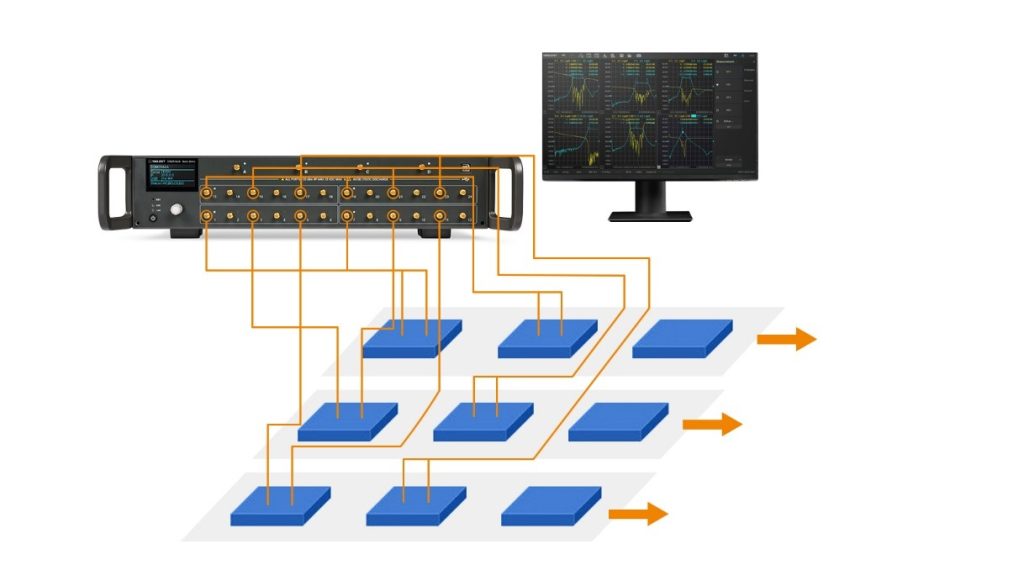
Improve the test throughput and reduce the test cost
4 How to realize the configuration and all-N port calibration of multi-channel network analyzer using SSM5000A
a) Establish physical connection
The analyzer (host) can be connected with SSM series switch matrix (slave) through USB, LAN or direct control interface to expand into an N-port network analyzer. After connecting the matrix, the analyzer automatically detects matrix type and assigns ports. The instrument information bar will display the prompt message “The switch matrix plugged in”. Select System > External Ports > Ext Port Enabled, the matrix switch identifier will be displayed in the upper right corner of the UI. As shown in the figure, the 4-port VNA combined with SSM5144A 4-24 switch matrix can be expanded into 24 single ports, 12 full-2 ports, 8 full 3 ports, 6 full 4 ports, 4 full 6 ports, 3 full 8 ports, 2 full 12 ports, and 1 full 24 ports vector network analyzer according to the specific test requirements, after expanding the port, the ports are from Ch1,Ch2, … to Ch24.

4-port VNA with 24-port test stand schematic diagram
b) Define RF configuration
After establishing physical connection between VNA and SSM, select Switch Matrix… and enter Switch Matrix RF Connections dialog interface to configure the switch matrix, allowing users to define the RF connection between VNA and SSM and the corresponding test ports. As shown in the figure, physical port1 (A) of the VNA connects to RF input port 1A of the SSM, physical port 2 (B) of the VNA connects to RF input port 1B of the SSM, physical port 3 (C) of the VNA connects to RF input port 1C of the SSM, and physical Port4 (D) of the VNA connects to RF input port 1D of the SSM. After RF port configuration is completed, click ok to apply VNA multiport expansion, and the expanded port is supported in basic calibration, port extension, fixture simulation, port power and other settings.
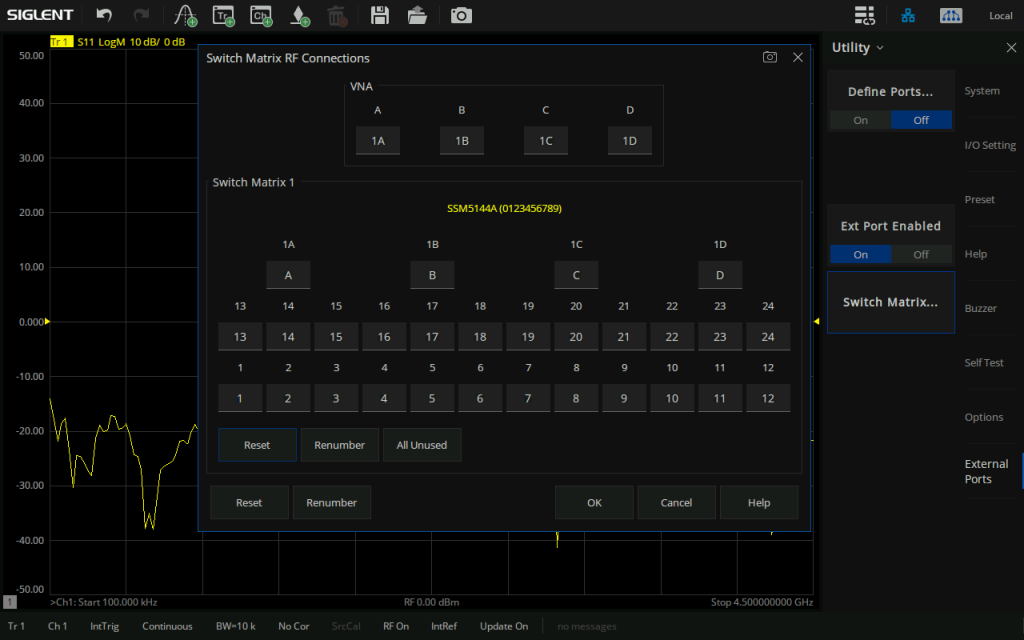
c) Set S parameters
Select Measurement>S-Params>Other… to enter the parameter configuration dialog. Users can customize the RF port number from the Receiver Port and Source Port drop-down lists. For example, S0214 is select the 2 as the receiver port and the 14 as the source port, or click Edit… menu under the Measure dialog box to enter the input edit box, enter 0214, and then select S0214.
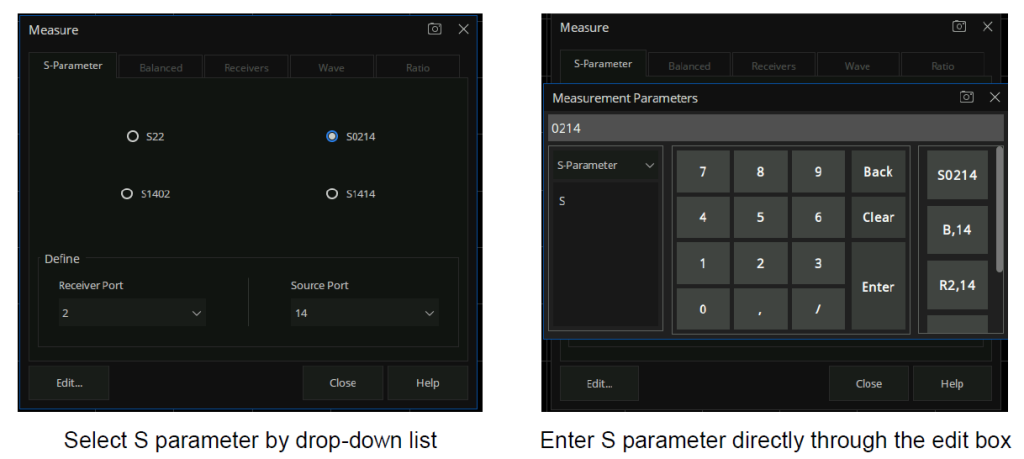
d) Multi-port VNA calibration
Calibrating multi-port VNA test system is more time-consuming and complicated than calibrating 2-port or 4-port VNA. Users can use electronic calibration kits or mechanical calibration kits for calibration, but it is very complicated to calibrate 10-port or 20-port with mechanical calibration kits. ECal calibration is a very convenient calibration method that greatly simplifies multi-port calibration while maintaining accuracy, and can replace traditional mechanical calibration kits to provide consistent calibration results and avoid human errors. The electronic calibration kit has good repeatability and stability because it contains solid-state electronic switches. SIGLENT provides 2/4-port electronic calibration solution with the frequency range of 9kHz-26.5GHz, which keeps one port of VNA and one port of electronic calibration kit unchanged as a reference, all other ports can be connected with the electronic calibration kit once to characterize the characteristics of all ports. The multi-port calibration wizard of vector network analyzer can effectively guide users to complete calibration and ensure that all required port combinations are calibrated.
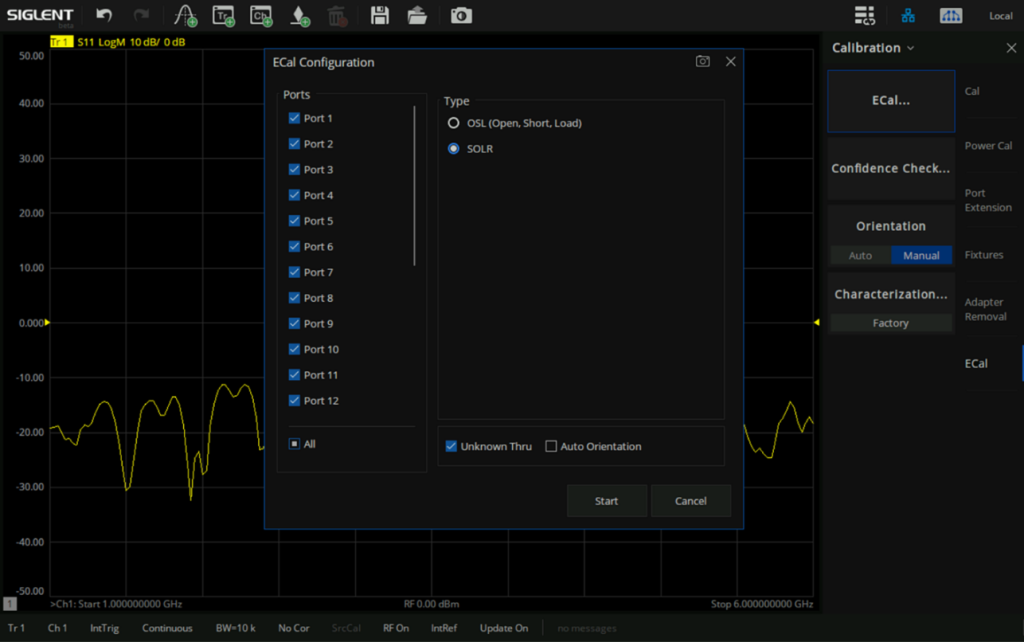
e) Calibration file save and recall
Take 16-port calibration as an example. After the calibration is completed, the configuration and calibration status of the C 16-Port can be displayed in the status bar, and you can add several traces to check the calibration status. Select Save Recall> Save State> Save State As as to save the status information and calibration data of the current multiport network. The suffix of the file is. csa. You can select Recall State to call the saved calibration data and file.
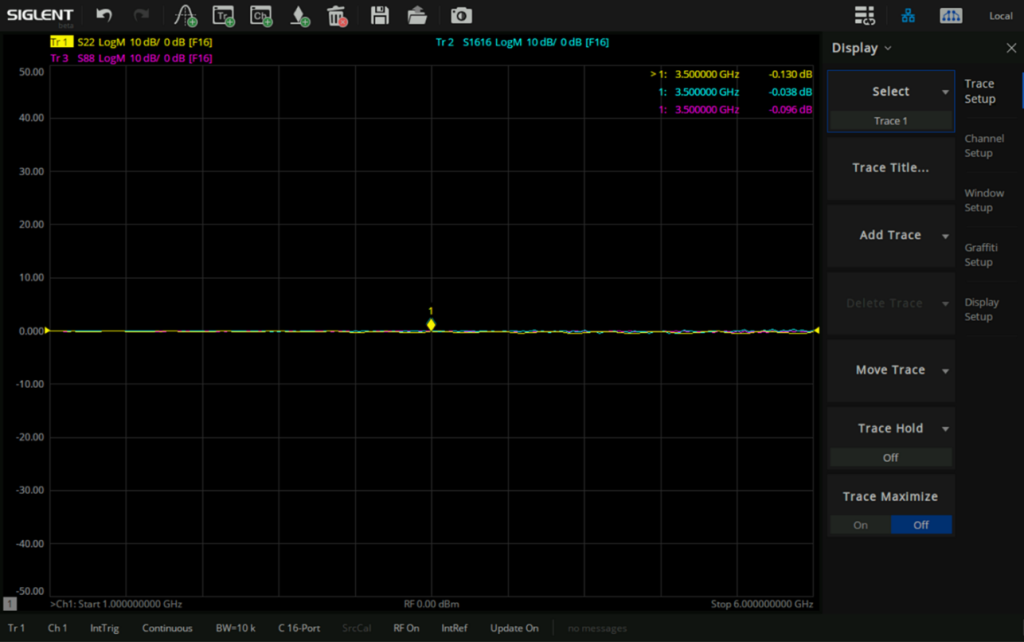
5 Configuration
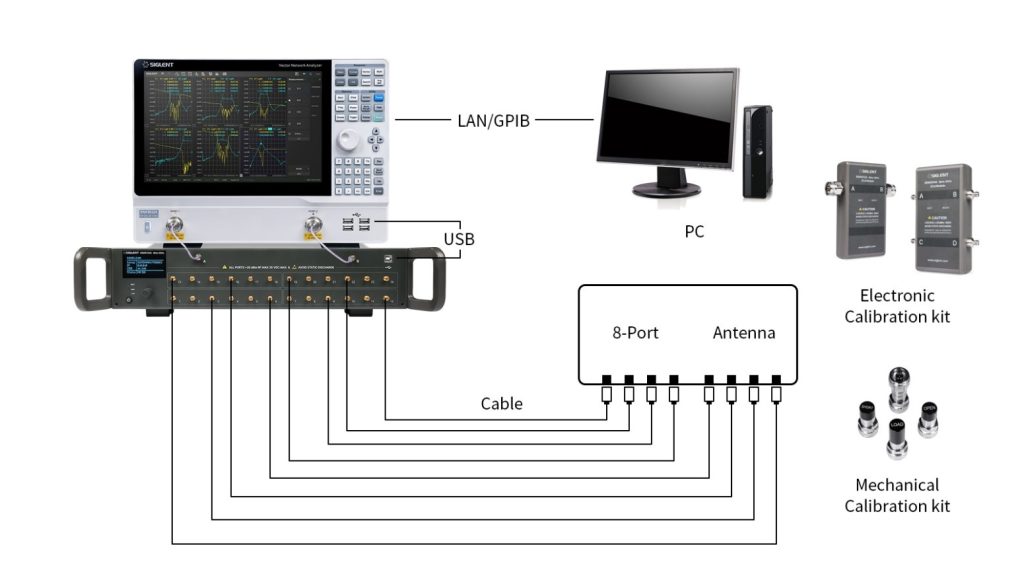
| Type | Quantity | Model | Description |
| Vector Network Analyzer | 1 set | SNA5000A | 2/4-port 9kHz-8.5GHz and 100kHz-26.5GHz Dynamic range: 125dB |
| Switch Matrix | 1 set | SSM5000A | Frequency range: 100kHz-26.5GHz Maximum number of input ports: 4 Maximum number of output ports: 24 RF connector: 3.5 mm female |
| Switch Matrix Option | 1 set | SNA5000-SWM | Support external matrix switch expansion port |
| Electronic Calibration Kit | 1 set | SEM5000A | 2/4-port Frequency range: 9kHz-26.5GHz RF connector: SMA, 3.5mm and Type-N |
| Cable | Several |
